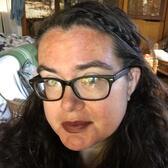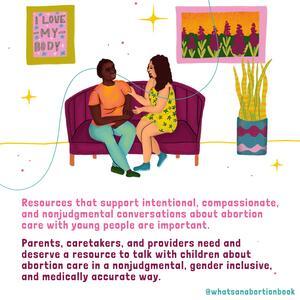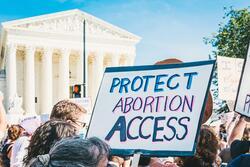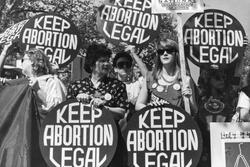Interview with Carly Manes, author of "What’s An Abortion, Anyway?"
With the news of the leaked Supreme Court draft decision to strike down Roe v Wade, conversations about abortion rights feel more urgent than ever. And despite what you might hear from the anti-choice crowd and even from some well-meaning people who support abortion rights, you can—and should—talk to kids about abortion. Now there's a resource to help you do it: What's an Abortion, Anyway?, written by Carly Manes, a white, Jewish, queer, full-spectrum doula, and illustrated by Mar, a brown, genderqueer artist who works under the name Emulsify, is a medically accurate, gender-inclusive book for kids that describes all the reasons people have abortions. It's a revolutionary work that anyone who's serious about abortion access and combating abortion stigma should own and share. JWA spoke with Manes about the intersection between Jewish faith and abortion, the obstacles in getting her book out into the world, and how Jewish communities can support the fight for reproductive justice.
JWA: Tell us about what went into your decision to create the book, and the process of getting it into people's hands.
Carly Manes (CM): I was working as an abortion doula at the Falls Church Health Center, and people would bring their kids with them when they came in for their appointments—they couldn't always afford childcare, and they'd say to me, "I want to explain this to my child." I'd Google "support resources for parents having abortions," and nothing ever came up except anti-choice stuff. Nothing else. The fact that I couldn't give them what they needed when I was there to support them felt bad, and I thought, "I'll just make it."
It took me three months to make a full draft. I had one in 2017 and had my first call with potential representation in 2018. I wanted to create an educational resource, and agents and publishers kept telling me to try a new angle, that a story about abortion would be more sellable. But when you tell one story about abortion, people get left out. I reached out to about 300 agents and didn't hear back. People didn't think the topic was appropriate—they were afraid to represent it.
After three years of no luck, I decided to do it on my own. I met Mar at an abortion doula conference in 2019, and they were excited to illustrate it. In March 2021, we had the final copy and images.
JWA: What impact have you seen from the book so far?
CM: We've gotten so many messages on Instagram expressing gratitude that the book exists and photos of kids with the book. Providers have reached out to us. They keep it in their waiting rooms—they tell us that this what they've been waiting for, a tool and resources to explain to kids what they do, to normalize abortion and reflect the people who have abortions, to affirm lived experiences.
JWA: How was abortion talked about when you were growing up? Was it discussed?
CM: My mom never explicitly talked about abortion with me, but once I learned what it was, she made clear that it was something she believed all people should have access to. I chose abortion as a topic for a paper when I was in eighth grade. It was the late ‘90's/early 2000's—I think it was the "Safe, Rare, and Legal" framework that Hillary Clinton had promoted. A really big difference from today, which is a blessing! I thought about it from the lens of polarization, as something that wasn't fully socially acceptable, with intense stigma attached to it. But when my mom found out I was writing that paper, she didn't treat it as though it was shameful.
JWA: What do you think Jewish communities are doing right when it comes to working for abortion access? Where do you think they can do better?
CM: I love that there's a loud Jewish presence talking about our faith tradition being abortion- positive. We're unashamed to tie religious values to abortion access—we're tying it to liturgy, we have textual evidence that abortion is mandated to save someone's life, that there's a broad definition of that. A lot of other faiths don't do that.
When I was working in Jewish organizations, a lot of folks really struggled with the concept of reproductive justice. Most Ashkenazi Jews couldn't see themselves in it, but that's a false conception. Reproductive justice is a framework for everyone that centers People of Color. People had to, and still have to, figure out how to show up as allies, to recognize that they have privilege. I think there has been a shift for the better, a resistance towards the old mindset, but we have to keep going.
[Note: The term "reproductive justice" was invented in 1994, but it's long been fought for by indigeneous women, women of color, and trans women. It's defined by SisterSong as the "human right to maintain personal bodily autonomy, have children, not have children, and parent the children we have in safe and sustainable communities.”]
In general, in the pro-choice movement, we've left very little room for the full breadth of experience around abortions. It's okay to be sad, confused, remorseful, to grieve. It doesn't mean you made the wrong decision—it doesn't mean it should be illegal. Allowing for the full range of emotions around abortion might encourage people to talk about it, if they saw their experiences reflected in narratives. In abortion doula work, we use the language of the person having the abortion. If the patient refers to their “baby," it's a baby. There's this idea…a dichotomy that says life is always good and death is always bad, but it's more complicated than that, and you can see that through faith-based lenses.
JWA: Where can people find the book and learn more about the fight for abortion access?
CM: You can order the book through the website. (If you can't afford it, email us and we'll send you a PDF.) Tell people about it, ask your local library, your school library, your synagogue library, to stock it. You can also spread the word about abortion funds and donate to them. In your communities, shift your language around abortion—talk about it without stigma. Have these conversations in Jewish contexts.









Awesome article! Such important work
What an evil mother this woman had. I wonder what her father thought about her eighth grade paper and her new book?